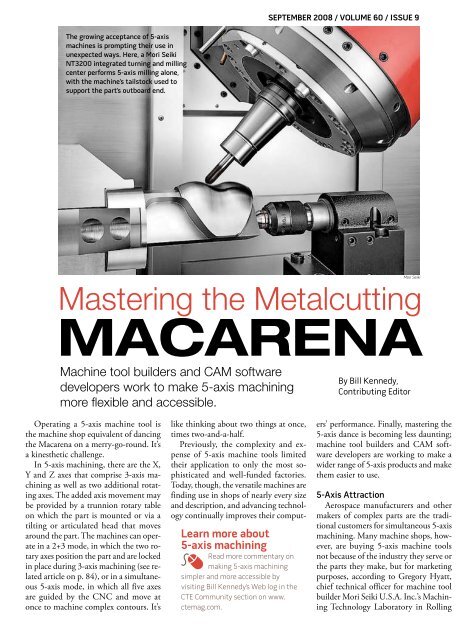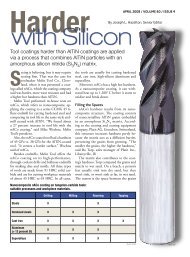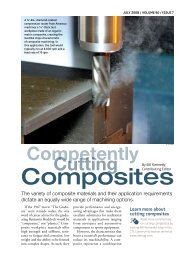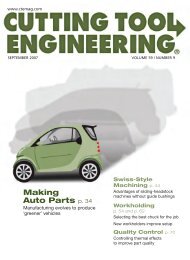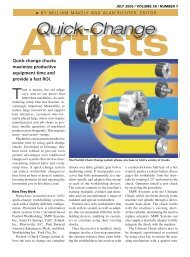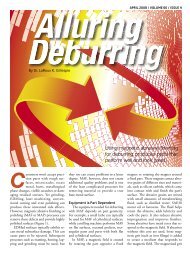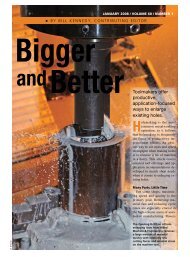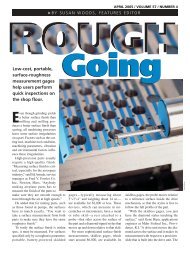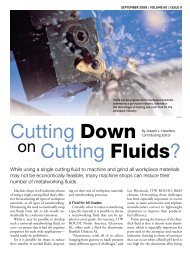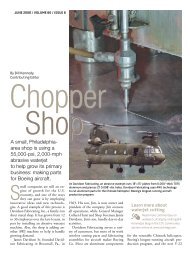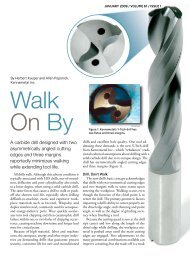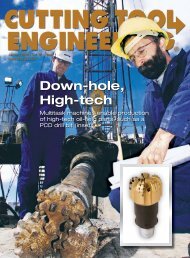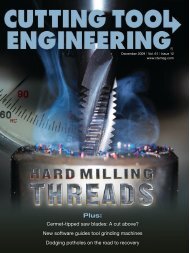MACARENA - Cutting Tool Engineering
MACARENA - Cutting Tool Engineering
MACARENA - Cutting Tool Engineering
Create successful ePaper yourself
Turn your PDF publications into a flip-book with our unique Google optimized e-Paper software.
The growing acceptance of 5-axis<br />
machines is prompting their use in<br />
unexpected ways. Here, a Mori Seiki<br />
NT3200 integrated turning and milling<br />
center performs 5-axis milling alone,<br />
with the machine’s tailstock used to<br />
support the part’s outboard end.<br />
Mastering the Metalcutting<br />
macarena<br />
Machine tool builders and CAM software<br />
developers work to make 5-axis machining<br />
more flexible and accessible.<br />
Operating a 5-axis machine tool is<br />
the machine shop equivalent of dancing<br />
the Macarena on a merry-go-round. It’s<br />
a kinesthetic challenge.<br />
In 5-axis machining, there are the X,<br />
Y and Z axes that comprise 3-axis machining<br />
as well as two additional rotating<br />
axes. The added axis movement may<br />
be provided by a trunnion rotary table<br />
on which the part is mounted or via a<br />
tilting or articulated head that moves<br />
around the part. The machines can operate<br />
in a 2+3 mode, in which the two rotary<br />
axes position the part and are locked<br />
in place during 3-axis machining (see related<br />
article on p. 84), or in a simultaneous<br />
5-axis mode, in which all five axes<br />
are guided by the CNC and move at<br />
once to machine complex contours. It’s<br />
like thinking about two things at once,<br />
times two-and-a-half.<br />
Previously, the complexity and expense<br />
of 5-axis machine tools limited<br />
their application to only the most sophisticated<br />
and well-funded factories.<br />
Today, though, the versatile machines are<br />
finding use in shops of nearly every size<br />
and description, and advancing technology<br />
continually improves their comput-<br />
Learn more about<br />
5-axis machining<br />
Read more commentary on<br />
making 5-axis machining<br />
simpler and more accessible by<br />
visiting Bill Kennedy’s Web log in the<br />
CTE Community section on www.<br />
ctemag.com.<br />
SEPTEMBER 2008 / VOLUME 60 / ISSUE 9<br />
Mori Seiki<br />
By Bill Kennedy,<br />
Contributing Editor<br />
ers’ performance. Finally, mastering the<br />
5-axis dance is becoming less daunting;<br />
machine tool builders and CAM software<br />
developers are working to make a<br />
wider range of 5-axis products and make<br />
them easier to use.<br />
5-Axis Attraction<br />
Aerospace manufacturers and other<br />
makers of complex parts are the traditional<br />
customers for simultaneous 5-axis<br />
machining. Many machine shops, however,<br />
are buying 5-axis machine tools<br />
not because of the industry they serve or<br />
the parts they make, but for marketing<br />
purposes, according to Gregory Hyatt,<br />
chief technical officer for machine tool<br />
builder Mori Seiki U.S.A. Inc.’s Machining<br />
Technology Laboratory in Rolling
Mastering the Metalcutting Macarena (continued)<br />
Meadows, Ill.<br />
“There are job shops that want to differentiate<br />
themselves by offering quicker<br />
delivery and quicker turnaround,” Hyatt<br />
said. “The part may have tolerances that<br />
allow it to be made in a conventional 3-<br />
or 4-axis machine—there is no 5-axis<br />
simultaneous geometry. But, in fact, by<br />
combining all the operations in the single<br />
5-axis machine, they have fewer set-<br />
ups, they can deliver urgently needed<br />
parts to their customers more quickly<br />
and can differentiate themselves.”<br />
Jeff Law, marketing manager for<br />
HMCs and rotary products at Oxnard,<br />
Calif.-based Haas Automation Inc.,<br />
agreed that minimizing setups and maximizing<br />
the number of features machined<br />
in the same operation are typical reasons<br />
for adopting 5-axis technology. “How-<br />
ever, the choice needs to be made with<br />
eyes open. Sometimes, you can be more<br />
productive with two setups simply because<br />
you can have two machines making<br />
chips simultaneously,” Law said. “Furthermore,<br />
5-axis typically means a sacrifice<br />
in rigidity—longer tools, spindly<br />
workholding standing off from the table<br />
surface—and a corresponding decrease in<br />
feed rates. However, for the right kind of<br />
part, 5-axis can’t be beat.”<br />
Machine tool builders offer differ-<br />
Haas Automation<br />
Cylinder head porting is performed on a<br />
Haas ES-5-4T HMC, a compact machine<br />
with a VMC-style enclosure that provides<br />
good visibility and access. A 5th-axis<br />
rotary table and fixture permits complex<br />
operations.<br />
ent types of 5-axis machines so machine<br />
shops have more choices. For example,<br />
a classic form of 5-axis technology is a<br />
mill/turn machine: a lathe with 5-axis<br />
milling capability. Mori Seiki builds several<br />
5-axis vertical milling machines that<br />
now have turning capacity, with one rotary<br />
axis capable of the rpm necessary for<br />
lathe operations. Hyatt said Mori Seiki<br />
offers three options for the C-axis’ rotational<br />
speed in its NMV series machines,<br />
with the highest speed exceeding 1,000<br />
rpm. The company debuts a new NMV<br />
8000 for large parts and an NMV 5000<br />
with enhanced automation features at<br />
IMTS ’08. For another 5-axis machining<br />
concept, see the sidebar on page 77.<br />
Also, some of these 5-axis machines are<br />
better suited to a certain class of parts.<br />
In general, Law said, a 5-axis machine<br />
that features an articulated spindle is effective<br />
on long parts and light cuts, so<br />
it’s suitable for aircraft wing spars. Trunnion<br />
tables can be best for cube-shaped<br />
workpieces, such as impeller blades, valve<br />
bodies and cylinder heads for singlecylinder<br />
engines. A long subtable that<br />
spins in one axis with a rotary table and
Mastering the Metalcutting<br />
Macarena (continued)<br />
tailstock at opposite ends is a good choice<br />
for prismatic parts like a V-8 engine’s<br />
cylinder heads. To handle various applications,<br />
Haas offers a range of 5-axis vertical<br />
machining centers (both trunnion<br />
style and articulated spindle) and 5-axis<br />
horizontal machining centers. The machine<br />
tool builder also offers dual-axis<br />
rotary tables and trunnion tables for use<br />
in 3-axis machines so they have 5-axis<br />
Haas Automation<br />
Five-axis machining of an impeller using<br />
a Haas TR-210 trunnion rotary table<br />
mounted on a Haas VF-5 VMC. Such dualaxis<br />
trunnion tables convert VMCs into<br />
affordable 5-axis machining centers.<br />
capabilities.<br />
Scott Baldus, application engineer for<br />
Okuma America Corp., Charlotte, N.C.,<br />
said shops looking at 5-axis technology<br />
should realistically consider their needs.<br />
If the machine will be used for basic positioning<br />
alone, numeric control of the<br />
rotary axes is not necessary. But jobs involving<br />
generation of odd angles and<br />
finer than 1° accuracy will require NC<br />
axis rotaries, as will continuous cutting<br />
of 5-axis contours on complex aerospace<br />
and medical parts, as examples. For<br />
heavy-duty applications, he cited Okuma’s<br />
MU series machines, which features
Mastering the Metalcutting Macarena (continued)<br />
a fixed spindle for maximum rigidity and<br />
a trunnion table to provide multimotion<br />
capability.<br />
In addition to increasing the variety of<br />
5-axis machines, machine tool<br />
builders are making them easier<br />
to operate. As an example,<br />
Law cited Haas’ most recent<br />
version of its control software.<br />
It features a graphic user interface<br />
that puts more information<br />
onscreen in every mode<br />
so the operator can more easily<br />
set up, program and operate<br />
the machine, without having to<br />
move between multiple screens<br />
to find needed information.<br />
As they are more widely accepted,<br />
some 5-axis machines<br />
are being used in unexpected ways. Hyatt<br />
said a growing application is the use of<br />
mill/turn machines for 5-axis machining<br />
even though no turning is being<br />
performed (see photo on page 68). The<br />
reason is fixturing for a long workpiece<br />
on a typical 5-axis machining center can<br />
interfere with the machining process. According<br />
to Hyatt, some manufacturing<br />
When running multiple sides of<br />
a part with individual setups on<br />
a 3-axis machine, an operator<br />
can indicate each side and run<br />
a program for it. That procedure<br />
changes, though, when a part is<br />
indexed on a trunnion table on a<br />
5-axis machine.<br />
engineers have assigned long parts to a<br />
mill/turn center and used the tailstock or<br />
subspindle to support the part’s outboard<br />
end. Typical workpieces are long aircraft<br />
structural parts, but components for oil<br />
field machinery, heavy equipment and<br />
machine tools also are candidates.<br />
Making the Move<br />
Consolidating multiple operations on<br />
one machine via 5-axis technology can<br />
save time and reduce workhandling, according<br />
to Rich Klein, applications manager<br />
for high-speed machining with<br />
machine tool builder OKK USA Corp.,<br />
Glendale Heights, Ill.<br />
However, he cautions that “programming<br />
issues can be a little more complex<br />
to work with. The part might be simple<br />
as far as the actual programming code<br />
that is required for each feature on the<br />
workpiece, but calculating correct positioning<br />
angles for the part is a little bit<br />
harder on the 5-axis side.”<br />
When running multiple sides of a<br />
part with individual setups on a 3-axis<br />
machine, an operator can indicate each<br />
side and run a program for it. That procedure<br />
changes, though, when a part<br />
is indexed on a trunnion table on a 5axis<br />
machine. “The need to have a work
Mastering the Metalcutting Macarena (continued)<br />
coordinate for each face can result in long<br />
setup times,” Klein said.<br />
To simplify the situation, OKK developed<br />
software called Multifacer II, which<br />
enables an end user to write programs for<br />
a part’s multiple faces by entering partprint<br />
dimensions at the machine control’s<br />
screen. Then, when moving from<br />
one side of a part to its next, the software<br />
creates programs to tilt the axis and define<br />
the new work offset. “You are only<br />
required to touch off your tools and set<br />
up your work offset for one side of the<br />
part. The software keeps track of part position<br />
and adjusts the offsets each time<br />
the part is indexed,” Klein said.<br />
Intended only for 5-axis positioning—<br />
not simultaneous 5-axis machining—the<br />
software (recently updated with additional<br />
features and a simpler user interface)<br />
can save a shop the expense of a<br />
new 5-axis CAM system. <strong>Tool</strong>paths can<br />
be programmed in a 3-axis CAM package<br />
or a program can be written manually for<br />
the part as if it was in an X-Y plane. Klein<br />
said an end user can put a part anywhere<br />
on the rotary table (further simplifying<br />
the setup process) because the software<br />
calculates the part position in relation to<br />
the rotary axis pivot points.<br />
For a shop considering using 5-axis<br />
technology for more than positioning<br />
work, the choice of CAM software is<br />
crucial, according to Okuma’s Baldus.<br />
“If the shop is not accustomed to 5-axis<br />
work and they are looking at bidding on<br />
it, it’s a fairly big step. When they get<br />
into actually machining on a rotary 4th<br />
and full 5-axis, there are a lot of things<br />
to take into account. In my experience,<br />
if they don’t already have a suitable CAM<br />
system, they need to evaluate their needs<br />
and then take a look at the players out<br />
there. Once they learn how to put out<br />
good code, setting up the job is no different<br />
that setting up any other job.” CAM<br />
programs differ in power, complexity and<br />
ease of learning, so Baldus suggested that<br />
a shop “sit down with a CAM program<br />
and get a feel for it.”<br />
Getting a feel also allows a machine<br />
shop to learn whether the program works<br />
as advertised, especially the post-processor,<br />
which outputs the G code. “Some<br />
CAM systems claim 5-axis capability, but<br />
the actual G code is not very clean when<br />
it comes out to the control,” said OKK’s<br />
Klein. “If it isn’t clean, you will not be<br />
able to get accurate, fluid motion out of<br />
the machine itself. We’ve seen quite a few<br />
instances where low-end software is used<br />
to do the programming, and when it is<br />
switched over to a more capable CAM<br />
system, the result is cleaner codes, and<br />
the performance, part accuracy and part<br />
finish improve.”<br />
Sim Saves Machine Time<br />
Another key facilitator in the application<br />
of 5-axis technology is accurate<br />
and reliable process simulation. “Simulation<br />
eliminates guesswork and the need<br />
to prove out new machining processes<br />
on real machines,” said Karlo Apro, senior<br />
applications engineer for Mastercam<br />
CAM software developer CNC Software<br />
Inc., Tolland, Conn. “Using a real machine<br />
to prove out a toolpath wastes valuable<br />
production time and risks potential<br />
CNC Software<br />
Simulation software, such as this<br />
Mastercam module that employs graphic<br />
displays of machine and tool interaction,<br />
eliminates guesswork and the need to<br />
prove out new machining processes on the<br />
shop floor.<br />
collisions.” Apro added that machine<br />
simulation is not only useful for finding<br />
errors in machine code, but also permits<br />
testing of different approaches and different<br />
cutting strategies on different machines<br />
to boost productivity, without the<br />
programmer leaving his desk.<br />
Tom McCollough, vice president of<br />
development at FeatureCAM, Salt Lake<br />
City, agreed that interest in 5-axis machining<br />
is growing across the board. He
Drawing a bead on 5-axis laser machining<br />
It’s the multIple axes of motion, not the cutting tools, that normally sets<br />
5-axis machines apart. Mitsui Seiki (USA) Inc., however, added a cutting tool not usually<br />
associated with 5-axis machining, an Nd:YAG laser, and recently launched the resulting<br />
machine tool as its VLD-300 5-axis vertical drilling machine.<br />
The Franklin Lakes, N.J.-based machine tool builder is known for offering ultraprecise<br />
5-axis machines. According to Scott Walker, president, a majority of Mitsui Seiki’s<br />
machine tools have 5-axis capability. Walker estimates that about 25 percent of those<br />
units machine prismatic parts, reducing workholding and fixturing, and 75 percent are for<br />
simultaneous 5-axis machining. The 75 percent indicates the sophisticated work being<br />
done by shops, many of them aerospace manufacturers, using the machine tools.<br />
About 3 years ago, some of those customers approached Mitsui Seiki seeking a way<br />
to increase speed when drilling thousands of small holes, typically 0.008" to 0.020"<br />
in diameter and 0.050" to 0.100" deep, in difficult-to-machine, high-temperature<br />
aerospace alloys. Engine components such as combustors, combustor liners and turbine<br />
blades may require as many as 3,000 small-diameter holes for cooling, and they have to<br />
be drilled at various angles in a noncontact manner.<br />
Mitsui Seiki combined its machine tool building and tool- and part-motion experience<br />
with an Nd:YAG laser to create its 5-axis vertical drilling machine. Engineered to handle<br />
smaller parts, the VLD-300 features an X-Y-Z capacity of 300mm×300mm×300mm.<br />
According to Tom Dolan, vice president, laser equipment requirements dictated that<br />
the spindle move only in the Z-axis, so all other axes of movement are controlled by<br />
the trunnion below the optic system. The machine features a rigid, cast iron bed and<br />
linear motor drives throughout, “something Mitsui Seiki has had a lot of experience<br />
with in our machining centers. We applied the same basic machining technology to the<br />
laser center,” Dolan said. He added that lasers offer a number of advantages including<br />
essentially zero tool wear, smaller heat-affected zones than EDM<br />
creates and the ability to produce shaped holes and angled holes<br />
in extreme length-to-diameter situations.<br />
Although introduced with an Nd:YAG laser, the VLD-300<br />
is engineered to also work with CO 2 , diode-pump and fiber<br />
lasers for different applications, including aerospace, electronic,<br />
medical and automotive parts. The equipment is ready to enable<br />
palletized robotic part loading.<br />
described the rising interest as “an outgrowth of more affordable<br />
5-axis machines, more affordable CAM technology and<br />
the general increasing sophistication of the customer.”<br />
FeatureCAM offers a 5-axis positioning module and shops<br />
have licensed it to reduce their workholding and fixturing requirements.<br />
Also, FeatureCAM added 5-axis simultaneous machining<br />
capability to the 2008 release. The addition is linked<br />
with FeatureCAM’s parent company, <strong>Engineering</strong> Geometry<br />
Systems, being acquired in 2005 by Delcam. Delcam provides<br />
5-axis CAM software. “We take that experience that Delcam<br />
has been generating over the years and put it into a versionone<br />
product in FeatureCAM, which is really not version one<br />
because it has been tested worldwide,” McCollough said. “We<br />
share not just knowledge but even actual code.”<br />
Also, FeatureCAM worked to include the 5-axis programming<br />
capability without making its software more difficult to<br />
use. “We took a long hard look at how we were going to put<br />
5-axis simultaneous cutting into FeatureCAM and not wreck<br />
it in terms of ease of use and automation,” McCollough said.<br />
“In a large variety of cases, it’s really an extension of our 3axis<br />
product. There is a lot of automation so that the customer<br />
Mitsui Seiki<br />
Employing an Nd:YAG laser, the Mitsui Seiki<br />
VLD-300 5-axis vertical drilling machine<br />
is engineered to permit fast, noncontact<br />
drilling of thousands of 0.008"- to 0.020"dia.<br />
holes in difficult-to-machine aerospace<br />
alloys. The laser spindle moves only in the<br />
Z-axis; all other axes of movement are<br />
controlled by the trunnion below the optic<br />
system.
LIGI <strong>Tool</strong> & <strong>Engineering</strong> puts 5-axis to work<br />
FIve-axIs machInIng Is essential to keep pace with the<br />
technological progress of LIGI <strong>Tool</strong> & <strong>Engineering</strong>’s customers,<br />
according to the machine shop’s leadman, Bob Bacon.<br />
Bacon made that statement to explain LIGI <strong>Tool</strong>’s purchase of a<br />
large Parpas Famu 5-axis Master P VMC at IMTS 2006. “With the<br />
proliferation of complex solid-modeling projects our customers<br />
produce, we are more than able to support them.”<br />
Located in Deerfield Beach, Fla., LIGI <strong>Tool</strong> provides precision<br />
production and prototype metalworking services and produces<br />
workholders and tool accessories. The shop’s capabilities include<br />
CNC turning and milling, sheet metal work and wire EDMing.<br />
Its shop equipment includes two 5-axis machining centers: the<br />
Famu machine and a Deckel Maho unit.<br />
Using 5-axis machining presented LIGI <strong>Tool</strong> with challenges,<br />
though. “When you see one of these machines in action at a show,<br />
it makes perfect sense to snatch one up and put it to work,” Bacon<br />
said. “Once it’s on the shop floor, you become a bit overwhelmed<br />
until you really think about it.”<br />
Besides the complexity of 5-axis machining operations,<br />
another challenge was holding the part to maximize tooling<br />
access. “Multiaxis machining is all about strategies and fixturing,”<br />
Bacon said. “The elegance of 5-axis is realized by the user/<br />
programmer. It’s actually a simple understanding between<br />
figuring how to position a part multiple times—3+2 axis—or<br />
moving the tool to all the features. It takes seeing this in your<br />
mind’s eye and visualizing how to hold the part so the machine<br />
can get to it.”<br />
LIGI uses Alphacam software for positioning work and Delcam’s<br />
PowerMILL for simultaneous 5-axis machining. “It still comes<br />
down to the post-processor,” Bacon said. “Quality time dedicated<br />
to producing a reliable post makes the rest easier.”<br />
“Basically, everybody needs 5-axis because it saves on setups,”<br />
said Sean Devanney, also a leadman at LIGI. “One setup and<br />
you do the whole part. On this machine, the head articulates all<br />
around the part, even comes up underneath it 5°. It’s a wonderful<br />
thing.”<br />
Devanney added a cautionary about programming in five<br />
axes. “There was a learning curve,” he said. “You have to consider<br />
three-dimensionally how programs might be being called up.<br />
In the old world, you’ve got X-Y-Z, and if something happens<br />
or a tool breaks, you just move the Z. But now the Z could be<br />
at a 40° angle. You can’t just go Z anymore, you have to go to<br />
combinations, so it’s a whole different mentality.”<br />
Bacon said 5-axis machining is “quite the adventure and a<br />
bit trying, but at the end of the day you can look at a part and<br />
say, ‘I can make that in one setup, no problem.’ And with enough<br />
practice, you actually can.” —B. Kennedy<br />
LIGI <strong>Tool</strong> & <strong>Engineering</strong><br />
The articulated 5-axis head on the Parpas Famu 5-axis Master P<br />
VMC at LIGI <strong>Tool</strong> & <strong>Engineering</strong> can move around a part and even<br />
approach it on a 5° angle from underneath.
Mastering the Metalcutting Macarena (continued)<br />
doesn’t have to make as many settings<br />
as he would have to in a more complex<br />
package. There are fewer things to interact<br />
with, and that is a huge part of what<br />
makes software easy to use.”<br />
McCullough, however, advised caution<br />
about 5-axis machining even though<br />
interest in it is growing. “It is important<br />
to know when 5-axis is appropriate and<br />
when it is inappropriate. We tell our customers:<br />
If you don’t need 5-axis, don’t<br />
use it! It adds an extra level of complication.<br />
I don’t know of any CAM vendor<br />
contributors<br />
CNC Software Inc.<br />
(800) 228-2877<br />
www.mastercam.com<br />
IS #320<br />
DP Technology Corp.<br />
(800) 627-8479<br />
www.dptechnology.com<br />
IS #321<br />
FeatureCAM by Delcam<br />
(877) 335-2261<br />
www.featurecam.com<br />
IS #322<br />
Haas Automation Inc.<br />
(800) 331-6746<br />
www.haascnc.com<br />
IS #323<br />
LIGI <strong>Tool</strong> & <strong>Engineering</strong><br />
(877) 523-6693<br />
www.ligi.com<br />
IS #324<br />
Mitsui Seiki (USA) Inc.<br />
(201) 337-1300<br />
www.mitsuiseiki.com<br />
IS #325<br />
Mori Seiki U.S.A. Inc.<br />
(847) 593-5400<br />
www.moriseiki.com<br />
IS #326<br />
OKK USA Corp.<br />
(630) 924-9000<br />
www.okkcorp.com<br />
IS #327<br />
Okuma America Corp.<br />
(704) 588-7000<br />
www.okuma.com<br />
IS #328<br />
or machining expert who wouldn’t say<br />
the same thing.” A sidebar on page 78<br />
describes one shop’s reasons for, and experience<br />
with, 5-axis technology.<br />
Nonetheless, many companies looking<br />
for CAM software seek a package that<br />
can handle both 5-axis indexing and simultaneous<br />
5-axis machining—even if<br />
their production doesn’t currently re-<br />
quire such machining, said Olivier Thenoz,<br />
mill/turn product manager for DP<br />
Technology Corp., Camarillo, Calif., developer<br />
of Esprit CAM software. “This<br />
trend goes along with the big boom of<br />
the mill/turn machines that are very<br />
competent 5-axis machines,” Thenoz<br />
said. “In the mill/turn market, there are<br />
also a lot of requests for 4-axis continuous<br />
milling with the B-axis locked in position.<br />
Such machining is handled by the
Mastering the Metalcutting Macarena (continued)<br />
5-axis module with most current CAM<br />
systems.”<br />
Thenoz added that CAM software<br />
developers are responsible for adapting<br />
to changing machine tool technology.<br />
“CAM programs have to adapt to<br />
the machine and not the opposite. Machines<br />
have limitations, maximum axis<br />
feed rates and travel limits, for instance,<br />
and CAM systems must be able to work<br />
around them.”<br />
Key to Wider Adoption<br />
DP Technology CEO Daniel Frayssinet<br />
said the key to wider adoption of 5axis<br />
machining is increased ease of use in<br />
CAM programs. “The prices of the machines<br />
are coming down, the technology<br />
is better and there are better holders and<br />
controls,” he said. “The big bottleneck<br />
right now is the programs.” Learning to<br />
program in five axes has traditionally<br />
been a lengthy process. According to<br />
Frayssinet, DP Technology responded<br />
by creating for Esprit a CAM platform<br />
DP Technology<br />
Increased ease of use is a key to wider adoption of 5-axis machining technology. This<br />
screen shot from the upcoming 2009 release of Esprit CAM software shows a new<br />
5-axis composite cycle based on decoupling the tool’s orientation from its motion on the<br />
part surface. The cycle gives users the flexibility to create a variety of 5-axis functions,<br />
according to DP Technology.
Mastering the Metalcutting Macarena (continued)<br />
that compares with other platforms the<br />
way Windows or Macintosh operating<br />
systems compare with DOS.<br />
Also, Esprit’s 2009 release includes a<br />
new, patent-pending “5-axis composite<br />
cycle.” It involves entering parameters on<br />
a single page that “is very graphic,” Frayssinet<br />
said. The cycle is based on decoupling<br />
the tool’s orientation from the tool<br />
motion on the part surface. This enables<br />
the user to independently define the toolpath<br />
and the tool orientation, which, in<br />
turn, defines the position of the tool axis<br />
while machining. DP Technology’s Thenoz<br />
said the composite cycle “provides<br />
maximum flexibility by allowing the user<br />
to select from a wide range of machining<br />
patterns and, likewise, a wide range<br />
of tool axis direction rules. The variety<br />
of choices gives the user the creativity to<br />
compose any complex 5-axis function<br />
with few limitations. Combining all the<br />
options, the composite cycle offers 20<br />
different strategies in a single cycle with<br />
logical choices for the user.”<br />
CNC Software’s Apro said CAM software,<br />
“in general, is always on the leading<br />
edge of technology, playing a balancing<br />
The key to wider<br />
adoption of 5-axis<br />
machining is increased<br />
ease of use in CAM<br />
programs. The prices<br />
of the machines are<br />
coming down, the<br />
technology is better, and<br />
there are better holders<br />
and controls. The big<br />
bottleneck right now is<br />
the programs.<br />
act between dreams and possibilities.<br />
Today, there are a number of machine<br />
builders offering a variety of multiaxis<br />
equipment in a wide range of configurations,<br />
quality and price. Computers are<br />
cheaper and CAM systems have come<br />
a long way, offering excellent multiaxis<br />
cutting strategies, with great tool control<br />
and large post-processor libraries<br />
for a reasonable price. As a result, even<br />
mom-and-pop shops can and do implement<br />
multiaxis machining.” CTE<br />
About the Author:<br />
Bill Kennedy, based<br />
in Latrobe, Pa., is<br />
contributing editor<br />
for <strong>Cutting</strong> <strong>Tool</strong><br />
<strong>Engineering</strong>. He has an<br />
extensive background<br />
as a technical writer. Contact him at (724)<br />
www.ctemag.com<br />
For more information, visit<br />
“Articles Archive Index” and select<br />
the “Machine <strong>Tool</strong>s” or the<br />
“CAD/CAM” category.<br />
CUTTING TOOL ENGINEERING Magazine is protected under U.S. and international copyright laws.<br />
Before reproducing anything from this Web site, call the Copyright Clearance Center Inc. at (978) 750-8400.


